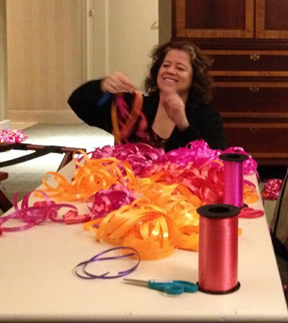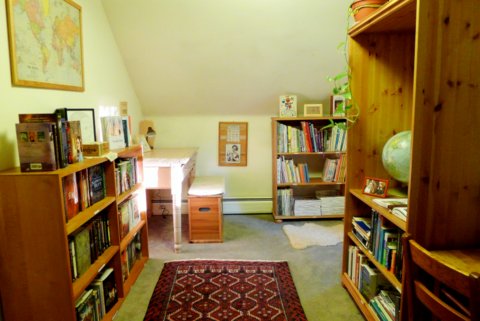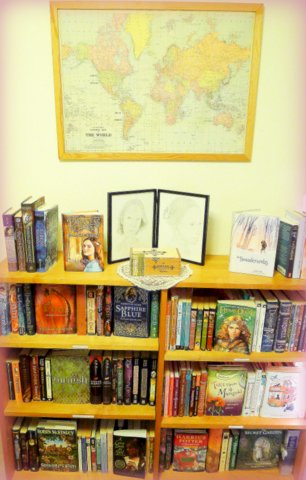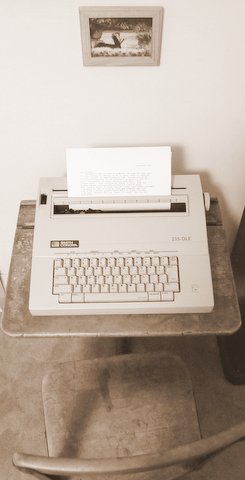This might come as a revelation to longtime readers of ShelfTalker, but I’m letting my complaints about the hurry towards each new holiday go. There will be no post in a month lamenting the rush to put out Christmas and Hanukkah books, because they will already be out, co-mingling with the books about turkeys and pilgrims.
We had a staff meeting last week, ironically in front of our Halloween display, and everyone thought the minute the last trick or treater had filled a bag of candy, we should put up the holiday books. Everyone looked at me. Last year there was a huge debate about when to put out the Christmas books. I lost, somewhat bitterly as I recall. It didn’t take much persuading this time for me to just give in to setting up the seasonal display November 1.
One of the things I love about owning a store is the freedom and flexibility to do what we think is the best thing for our store, for our customers, and for our staff. Putting out the ever-growing shelf of holiday books will help the overflowing back room which will feel like a new lease on life for the staffers who spend any time in there. (Honestly, isn’t every bookstore’s back room right now just chock full of fourth quarter goodness that can’t really go on the shelves yet?) Our customers will like it because they won’t have to ask where the holiday books are, and they’ll buy what they need. And it’ll be good for the store, because we won’t lose those early holiday sales.
So, this thing called compromise has finally entered my retail life. But never fear, I will still complain about other things, like how much it hurts to cut yourself on a cardboard box, or dumps that are impossible to put together, or why it is that the day your special orders really need to come, they’re stuck at the UPS facility in Connecticut.
One thing I promise that will not get rushed is the wearing of the Santa hat.
It’s All in the Curling Ribbon
Elizabeth Bluemle - October 7, 2013
When I arrived last night at the annual New England indie bookseller trade show in Providence, R.I., I imagined some possible blog posts I might write while I’m here: recaps of the helpful educational sessions and special events, perhaps, and tips for both new and seasoned booksellers. But it’s long past 12:30 a.m. after a long day filled with conversation, and I find it’s curling ribbon I want to talk about.
The NEIBA trade show has always been a thermometer of the book business. The number of attendees fluctuates from year to year—one indicator of the health of regional bookselling—and the seminar topics do a pretty good job of reflecting current concerns. Back when Josie and I first came to NEIBA, in 1996, everyone was in an uproar about something mysterious (to us newbies, whose store hadn’t even opened yet) called the “vendor of record” program. The vendor of record debate peaked and subsided fairly quickly, only to be replaced by concerns about chain stores, then chain store pressure shutting down independents, then online vendors, then mega-online-opolies, then e-books. There is always something pushing independent bookselling up an ever-steepening slope.
And yet.
Something magical happens at the trade show. Surrounded by kindred spirits—folks who understand from the inside what it means to fight the good fight for great books and authors and artists, and for the vitality of community bookstores day after day—in each other’s company, we all light up. We are inspired by each other.
After a day filled with helpful sessions and a lovely keynote and an evening celebrating New England Book Award winner speeches, I found myself on the floor of Carol Chittenden’s hotel room unwinding and cutting and tying and curling spools of ribbon for the next morning’s author breakfast. Booksellers Jan Hall (co-chair of the New England Children’s Booksellers Association and co-owner of Partners Village Store in Westport, Ct.) and Sara Hines (Eight Cousins bookseller and NECBA member) were similarly occupied, and the four of us sat and worked and chatted about books and bookselling. (And gift wrapping. Surrounded by all that ribbon, we couldn’t help talking about it. You’d be surprised how much thought goes into bookstore gift-wrapping policies and procedures, and how useful it can be to compare notes.)
The thing is, we can’t get enough of this collegial talk. It’s like sparkling spring water, essential and delightful and necessary. What the trade shows provide us with, in addition to education and the chance to discover new titles and sidelines and services for our bookstores, is a place to sit on the porch together. We vent some, and share crazy anecdotes from our stores. We share book passions, titles from the year that blew our hair back, and we eagerly collect and share individual store “best practices” from the tribe on how other members streamline or maximize or emphasize or add value to everything that we all do, from handling consignment sales to doing school and teacher outreach to creating more effective displays to overhauling our websites. The veteran booksellers have invaluable experience and wisdom to share, and the younger ones have energy and enthusiasm and new ideas.
For the next two days, the Rhode Island Convention Center will be filled with chatter and laughter in every corner, and I will be soaking it all up. Sitting there tonight, curling ribbon after ribbon with my colleagues as we talked shop, the accumulation of years of this kind of sharing struck me as sweet and sharp as the scissors’ edge slooping along the underside of the strips. And what a bountiful curl it produces!
Non-Book Questions
Josie Leavitt - October 4, 2013
Booksellers in touristy communities get asked a lot of non-book questions every day. They usually range from the basic, “Where can I get lunch?” or “How do I get to the museum?”, etc. But every so often we get asked some very odd questions that presuppose that independent bookstore staff know everything. Of course, with Google and our knowledge of the area we are often encyclopedic in ways we can help.
Here are some examples of things I’ve been asked in the past few months.
– Where can I find a real estate agent? People smartly check out our town and see a thriving village filled with a bookstore, a great coffee shop, an antique store, a toy store, a country store, an upscale gift shop and a myriad of wonderful restaurants and start having fantasies of moving to our idyllic hamlet. I cannot remember how many people I’ve given my realtor’s name to, but I know at least eight of them have bought houses from her since we’ve been open. What’s great about this exchange, is these folks become good customers and eventually, friends.
– Where can my son get a haircut? This was asked by a woman at 4:30 on a Sunday for her adult son who was with her, standing awkwardly running his hands through his slightly shaggy hair. We did a little Internet search and sent her flying out of here to get the last appointment at the Supercuts up the road. Why her son, who really needed a comb more than anything, wasn’t in charge of his own hair was puzzling to me, but I don’t judge. They both seemed okay with the exchange and he happily got in the car to get that last haircut of the day.
– Where is the Shelburne Inn? We get asked this a lot because our store and surrounding apartments used to be a hotel. Even now, almost 10 years after the Inn closed, we get folks weekly, asking where they can check in. They come right up the counter, which is where the registration desk used to be, and ask for a room. Some even keep asking hoping against hope that keys to a room will magically appear. Folks have even asked, “Are you sure?” This leads to the inevitable “where else can I stay?” discussion. Sometimes, when it’s high season, we’ll call around to the various hotels and check availability just to save the heartbreak of driving around and not getting a room.
– I had someone call the store several years ago and ask where he could buy porn. It wasn’t a dirty call, he just needed some porn. I told him we didn’t really carry any porn and he asked if I knew where he could some. I didn’t and this one time I did not avail myself of the Internet to help.
– Giving directions seems to just be part of the job of anyone who works in a bookstore. It’s heartwarming how people will just stop when they see a bookstore and ask for help for just about every thing they need. It makes such sense because bookstores contain within them most everything you need to know. And that is beauty of books.
What’s the strangest question you’ve been asked in your store?
Favorite Picture Books of the Fall
Josie Leavitt - October 3, 2013
It’s that time of year again, when carton upon carton of new, yummy books stream into the store. As overwhelmed as we can get with trying to find the proper homes for all these lovely books, we all marvel at the stunning selection. This is just a brief round-up of a few of my favorites so far this fall.
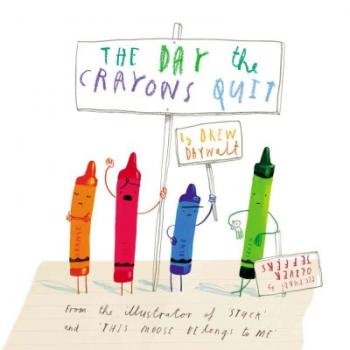 Okay, my first book is from the summer. The Day the Crayons Quit came out in June and I’ve been meaning to write it up ever since it came. This book is just flat out funny. All 12 crayons leave letters for young Duncan about what’s going for them. Yellow and orange aren’t speaking anymore, white is just sad, grey can’t handle coloring in another elephant, peach is naked because Duncan peeled off the wrapper, etc. The examples are great and the text is quite funny. One of my favorite lines in from the publication info page where it says, “The art for this book was made with…um…crayons.”
Okay, my first book is from the summer. The Day the Crayons Quit came out in June and I’ve been meaning to write it up ever since it came. This book is just flat out funny. All 12 crayons leave letters for young Duncan about what’s going for them. Yellow and orange aren’t speaking anymore, white is just sad, grey can’t handle coloring in another elephant, peach is naked because Duncan peeled off the wrapper, etc. The examples are great and the text is quite funny. One of my favorite lines in from the publication info page where it says, “The art for this book was made with…um…crayons.”
Elisha Cooper’s book Train is an ode to joys of all types of train travel across the country.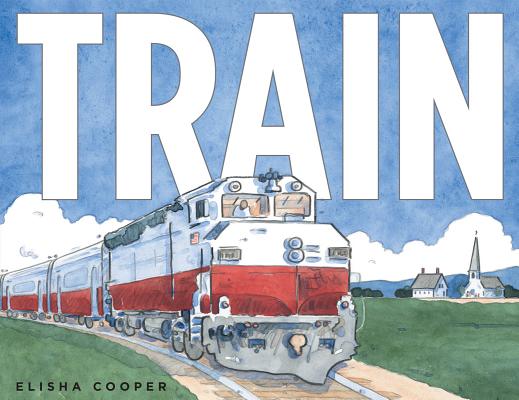 Train lovers will revel in the details of all the different kinds of trains: commuters, freight, high speed, etc. It’s clear that Elisha has a love of trains and the translates that into something that little kids will enjoy. The reader can almost hear the gentle rhythm of the trains as they go about their journeys. This book would appeal to many adult train-lovers as well.
Train lovers will revel in the details of all the different kinds of trains: commuters, freight, high speed, etc. It’s clear that Elisha has a love of trains and the translates that into something that little kids will enjoy. The reader can almost hear the gentle rhythm of the trains as they go about their journeys. This book would appeal to many adult train-lovers as well.
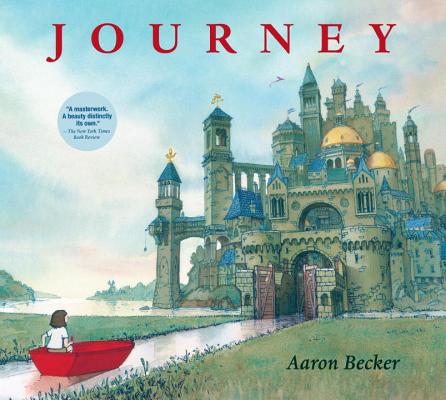 Every year there is a wordless book that takes my breath away. This year, Aaron Becker’s Journey is that book. The book begins with a washed-out palette, save for red. A young girl tries to get her family to play with her; the scooter, kite and ball are ignored by all. Finally she takes a red crayon and draws a door on the wall and enters a magical world full of color. What I absolutely adore about this book is the use of red and purple as the colors of her imagination, escape and friendship. I just “read” this book with a customer and we both got goosebumps. High praise indeed.
Every year there is a wordless book that takes my breath away. This year, Aaron Becker’s Journey is that book. The book begins with a washed-out palette, save for red. A young girl tries to get her family to play with her; the scooter, kite and ball are ignored by all. Finally she takes a red crayon and draws a door on the wall and enters a magical world full of color. What I absolutely adore about this book is the use of red and purple as the colors of her imagination, escape and friendship. I just “read” this book with a customer and we both got goosebumps. High praise indeed.
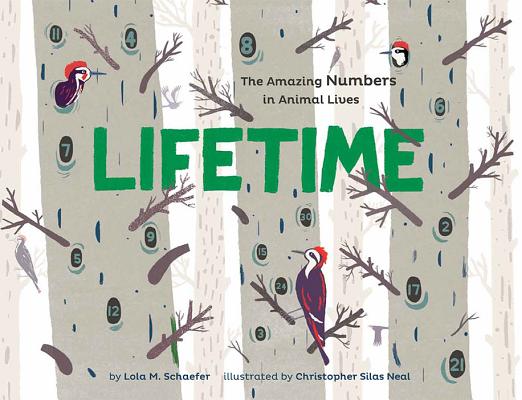 Lifetime: The Amazing Numbers in Animal Lives by Lola M. Schaefer, illustrated by Chirstopher Silas Neal, is a fact-filled beautifully illustrated book about animals. Kids who are nonfiction fans will enjoy learning that rattlesnakes add 40 beads to its rattle during its lifetime and that giraffes have 200 spots. The numbers get larger as the book progresses. This is a fun counting book with animals.
Lifetime: The Amazing Numbers in Animal Lives by Lola M. Schaefer, illustrated by Chirstopher Silas Neal, is a fact-filled beautifully illustrated book about animals. Kids who are nonfiction fans will enjoy learning that rattlesnakes add 40 beads to its rattle during its lifetime and that giraffes have 200 spots. The numbers get larger as the book progresses. This is a fun counting book with animals.
I’ll have another update of great picture books that come out in October. What are some of your favorite picture books this season? And, I’m going to start the Caldecott buzz now and just suggest that Journey should be right at the top of everyone’s list to win a shiny sticker.
Let’s Talk About Shipping
Josie Leavitt - October 2, 2013
Okay, I need to vent about shipping for just a moment. I get countless boxes a day and for the most part the books arrive packaged the way they should and there are few damages. And then there are the packages that make me wonder what’s going on in shipping departments.
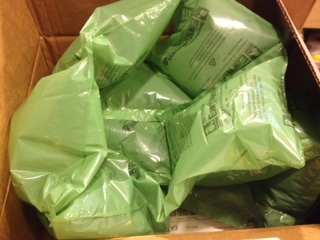 There is a new phenomenon happening where tiny things, books, or puzzles are shipped in very large boxes surrounded by those pillow packs of air. This sort of packaging takes up a lot of space, in a box and in the store. And, after a confirmation call to my local solid waste department — they cannot be recycled. So, here’s an example of a poster being sent in a large box, surrounded by pillow packs of air. The
There is a new phenomenon happening where tiny things, books, or puzzles are shipped in very large boxes surrounded by those pillow packs of air. This sort of packaging takes up a lot of space, in a box and in the store. And, after a confirmation call to my local solid waste department — they cannot be recycled. So, here’s an example of a poster being sent in a large box, surrounded by pillow packs of air. The  irony here is, the poster is in its own hard cardboard tube that could easily have been shipped by itself. This sort of shipping decision makes me crazy. Not only is it wasteful, the packing material is so voluminous that it takes up half of my back room. I know I could find people who could use this material (and we do have a staffer, Darrilyn, who is amazing about finding homes for bubble wrap), but I don’t have the space to store it.
irony here is, the poster is in its own hard cardboard tube that could easily have been shipped by itself. This sort of shipping decision makes me crazy. Not only is it wasteful, the packing material is so voluminous that it takes up half of my back room. I know I could find people who could use this material (and we do have a staffer, Darrilyn, who is amazing about finding homes for bubble wrap), but I don’t have the space to store it.
I wrote a blog post early on in my ShelfTalker time about hurting myself with a Baker and Taylor box. They had recently switched to a new box system that involved a lot of glue, very strong glue. Sadly, these boxes remain and they still can’t be recycled or reused easily because of the glue and the plastic wrap that’s permanently stuck to the bottom of the box. My heart sank the other day when I saw that a publisher had switched to this kind of box as well. The problem with this kind of box is they are very hard to break down and they don’t stack easily. I know this sounds like a minor problem, but when I get a six-box shipment and the boxes topple over the rest of the recycling because they can’t lay flat, it’s a problem. Okay, it’s a minor problem, but it’s still irritating.
One last vent and then I’m done, I promise. This has nothing to do with the packaging from publishers, but from the carriers themselves. Why are the boxes so dirty these days? I’m not sure what’s happening in the back of these trucks, but it’s so dusty that sometimes boxes that aren’t well sealed come in the store covered with a layer of grit and grime. And if I pick the box up the right way and use the “lift with your legs” method, my shirt gets dirty.
But, every day, a very large percentage of packages come unharmed, clean and ready to be put on the shelves, and let’s face it, any day where I get look at all the great books that come in is a pretty darned good day.
Things Not to Do in a Bookstore
Josie Leavitt - September 30, 2013
Every once in a while I like to make a list of things customers might want to think twice about doing when they come to a bookstore. This list is not intended to make anyone feel bad, but rather is a helpful guide to ensure the best shopping experience possible.
– If your children are hungry, tired or sick and you’re not in a position to buy them a book, maybe the library is a better place to go. I totally understand that families can’t always buy books when they come to the store, but bringing in a passel of kids before lunch and asking them to browse for what they might like for Christmas just seems a little mean.
– Don’t apologize for not knowing the title of what you’re looking for. Something happens the minute people enter a bookstore: they forget almost immediately what they’ve come in for. We’re used to puzzling out what you’re looking. In fact we like the challenge. It’s our job and we’re happy to do it.
– Please respect the no food in the bookstore rule. We aren’t being capricious, we’re trying to protect books from sticky fingers, so that every book remains gift-worthy. We’re happy to let you enjoy your snack on the deck and then welcome you into the store. Our store is next to a bakery and a candy shop, so this can be challenging.
– If you’re in a massive hurry, please don’t take that out on us. We all do the best we can to speed you along, but sometimes staffers are busy with other customers. Calling ahead is hugely helpful. If we have time we can get your book – usually it’s a present for a party that starts NOW – wrapped and ready to be picked up fairly effortlessly. A tiny bit of planning can make shopping fun and easy.
– Please don’t feel sheepish about reading a book to your kids. We love that. And we’re not listening, too much. Nothing makes me happier than hearing a lively story read aloud and a small child laughing and interacting with her parents and the book.
– Don’t whisper. We’re not a library. It’s totally fine to have lively conversations about books when you’re here.
– Don’t talk on your cell phone in the store, especially when we’re ringing you up. It’s rude.
– Don’t assume we can’t get your book. We can’t have every book in stock and sometimes we’re just out of the “hot” book. Most indies get books in every day and we’re happy to do our best for you.
– Don’t be shy about telling us about a book that you love. We value your opinion and enjoy hearing about books you enjoy. I’m not a big history reader, so I rely on my customers’ savvy to help me with that section. We welcome your input.
– Lastly, don’t be a stranger to the bricks and mortar store. Some of you might have lovely relationships with your e-readers, but all indies need your help. So, buy a few books from us as well. While you might not miss yet, you would if we were closed, so help us stay in business by buying e-books from us and getting the occasional physical book from us. A shift of a few book purchases from Amazon or other online retailers can help us more than you know. We won’t make you feel bad, I promise, we’ll just be happy to see you again.
The Ultimate YA Definition?
Elizabeth Bluemle - September 27, 2013
Last week, Maine bookseller Kenny Brechner (DDG Booksellers) invited readers to define the somewhat slippery category of reading we call young adult literature. He offered acclaim and prizes for ShelfTalker contestants attempting to nail down the cagy beast, and here, now, are the results.
Kenny writes:
It is a wonderfully appropriate irony to acknowledge that the reason we cannot adopt a simple or clever definition of Young Adult Literature is because the defining characteristics of young adulthood obviate answers of that kind. Clever definitions, such as Napoleon’s description of History as “a pack of lies agreed upon,” can be fun and informative, but are, above all, clinical, a state which is the antithesis of the YA condition.
A telling theme which runs though the thoughtful answers provided to our contest is that Young Adult literature requires of its protagonists that an immediacy of emotional response, and a freshness of intellectual perspective, be associated with their transition to adulthood. That being so, YA lit certainly deserves a definition worthy of its character.
The idea that YA is tied to transition is very well captured by Paul’s definition. “If youth was measured by a clock, and the end were to occur when both hands struck twelve, then YA stories are those that take place between 11:59 and a couple seconds after midnight. I think that they end when the protagonist (generally a teenager) has a foot – or maybe just a toe – planted on both sides of the innocence/experience fence.”
Another key point is that YA narratives are not retrospective. As Judy points out “First or third person, present or past tense can all be YA. What is important is the immediacy of the story and the point of view of the teen. This is different from adult fiction that reflects back on what happened to the protagonist as a teenager.” Rachel also speaks to this idea in noting that “YA is less about the intended audience and more about the experience–YA lit speaks to the teenager, current or past, in its readers, regardless of the protagonist’s age. Conversely, adult literature speaks from an adult experience of life, even when the protagonist is a teen.”
These are the key characteristics which define the genre, immediacy of experience and a coming of age immersed in actual experience, unvarnished by time and the dampening of emotion. Perhaps this explains the strong appeal of YA literature to adults who wish to revisit that peculiar and powerful world in themselves.
All right, then, the winning definition is this composite one:
If youth was measured by a clock, and the end were to occur when both hands struck twelve, then YA stories are those that take place between 11:59 and a couple seconds after midnight. They end when the protagonist has a foot – or maybe just a toe – planted on both sides of the innocence/experience fence. First or third person, present or past tense can all be YA. What is important is the immediacy of the story and the point of view of the teen. YA lit speaks to the teenager, current or past, in its readers, regardless of the protagonist’s age.
Our three winners will, as promised, receive:
1. Respect, admiration, and a deep sense of personal satisfaction.
2. And… a secret prize will also be mailed to them, one that could retrospectively change their lives forever!
Many thanks to everyone who chimed in.
Gwen and Kate’s Library, Done
Josie Leavitt - September 26, 2013
Last month I had the pleasure of blogging about two sisters, whom I call Gwen and Kate, in the post They’re Starting a Library. These young women decided to share a room so that they could turn Kate’s room into a library for their family. Their mom, Deirdre, emailed me some photos of the finished room. Not only are these girls just wonderful, their library is stunning and whoever took the pictures has some serious talent.
I love stories like this. So often in the book world of late, it’s always doom and gloom. Can the indies survive? Are we adaptable enough? Are we losing customers to Amazon? There are many questions booksellera face everyday, and every day seems to bring with it another set of issue to be dealt with. But if we can pick our heads up long enough and look around, we can see some pretty amazing relationships customers have with books. We are in this business because we love it; we’re not getting rich doing this, but every day there is real joy in bookselling. It can be as simple as a child hugging a book and skipping to the car, eager to read, or someone sharing a story about a fun book group discussion, or someone telling us why we have to read a certain book. Books create passion in people and that is a great way to spend a day.
These girls, Gwen and Kate have such passion. Their desire to create a library is one of great passion. They literally rearranged their lives so that they could have their library. This is a story for the ages. We’ve had kids love books and tell us what they mean to them, but never in all our years of being in business have kids willingly shared a bedroom so that they would have a special place for their books. Here are the pictures. I’m hoping to get regular updates as the room changes and their collection grows.
Can’t Sign a Kindle
Josie Leavitt - September 25, 2013
Two nights ago we provided books for the launch party of Eileen Rockefeller’s lovely and thought-provoking memoir, Being a Rockefeller, Becoming Myself. The event was held at the Coach Barn at Shelburne Farms, possibly one of the most gorgeous places in Vermont. There was a festive air to the evening because Eileen lives in town and people were celebrating her book. We were thrilled to be providing her books for the party.
We had stacks of books set up and people were buying, often more than one copy. Folks who weren’t buying felt compelled to explain why. More often than not, they’d already purchased their copy from us earlier. A few sheepishly explained that they’d read the book as a galley. But we heard from at least 10 people that they’d already downloaded the book on their Kindle. Interestingly, no one mentioned any other kind of e-reader, just the Kindle. In the beginning of the evening, before Eileen’s lively, informative, and heartfelt presentation, the Kindle owners just avoided the sales table.
Then an incredible thing happened. People were so moved by Eileen’s presentation, they wanted a book, a real book that could be signed and personalized. They came back up to the sales table and bought heaps of books. All of them saying, “Well, it’s not like she can sign my Kindle.”
It was gratifying to finally be on the winning end of an e-reader argument. Yes, they’re convenient, yes, they hold a lot, but in the end, they’re missing the whimsy of a real book and the value of a book in terms of creating a memory. And I left thinking, the physical book wins again. That was a very happy thought.
If You Give a Bookseller a Cookie….
Elizabeth Bluemle - September 23, 2013
Sometimes I feel like the bookselling day is just one long version of Laura Numeroff’s If You Give a Mouse a Cookie. This is a book I’m sure you’re familiar with, but just in case you have recently arrived in the United States from a country that hasn’t yet translated it, If You Give a Mouse a Cookie follows a little mouse’s long list of requests, each following from the previous one, after receiving a cookie. He asks for a glass of milk, then wants to see his milk mustache in a mirror, then needs some scissors to give his fur a trim, and so on. Just one thing after another, leaving a trail of partially-finished tasks and a bit of a mess behind. This is EXACTLY what running a bookstore is like. And so … I present:
If You Give a Bookseller a Cookie (with apologies to Laura Numeroff)
If you give a bookseller a cookie, she will think of If You Give a Mouse a Cookie and go to the picture book section to check stock on all of the Numeroff/Bond titles.
Once there, she will encounter a flurry of books scattered on the floor by a family of toddlers, and stop to reshelve them.
Putting something back in the Caldecott section, she will notice that she is almost out of McCloskeys, and that the Wiesners and Van Allsburgs and Bangs really need to be re-ordered, as well.
Heading back to the computer to add the books to purchase orders, she will be stopped by a customer looking for a copy of a history book by a local author, and will check six areas of the store — History, Vermont, Staff Picks, New & Notable, overstock, and the special order bookcase — for the single title the database says she has, before suddenly remembering it is in a window display.
After ringing up the sale, she will need to fill the gap left in the window display, and will scan the History, Vermont, Staff Picks, New & Notable, and overstock shelves to find just the right pick.
In the overstock room, she will encounter a box of games that arrived damaged and is awaiting a UPS pickup call tag from the vendor. The box has been there for two weeks, so she will head to the phone to call the vendor to check on the status of the call tag.
On the phone, she will be placed on hold to scratchy, loud music. While waiting, she will put the Caldecott books on publisher orders.
Putting titles on pub orders will remind her of a stack of packing slips that require calls to vendors to retrieve shipping costs and invoice totals so she can finish receiving those orders and shelving the items.
The packing lists will remind her that she needs to box up and send three copies of a book to a California customer, who ordered titles for a nearby New York State author to autograph.
Finding the shipping label folder empty, she will go to computer station 2 where the label file lives, fill the printer with label paper, and print out 25 sheets. Filling out the label for the California customer reminds her that her favorite California author has a new book going on sale next week, which reminds her that there’s a stack of books on the back counter that she’s been waiting to shelve until today’s on-sale date.
Shelving the new titles while holding the phone to her ear (still on hold), she will be approached by leaf peepers (fall colors tourists) looking for the cafe next door. The building has a wraparound porch, and it’s not a large building, so she’s privately not sure how they got lost, but she cheerfully directs them next door.
In thanks, the tourists will bring her a cookie….
And that, my friends, is the first fifteen minutes of pretty much any work day at a bookstore!

